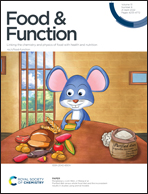Association between non-tea flavonoid intake and risk of type 2 diabetes: the Australian diabetes, obesity and lifestyle study†
Abstract
Studies examining the association between flavonoid intake and measures of insulin resistance and β-cell dysfunction, as markers of type 2 diabetes (T2DM) across the adult lifespan, may provide insights into how flavonoids influence T2DM risk. This study examined the cross-sectional associations between flavonoid intakes, from dietary sources other than tea, and biomarkers of glucose tolerance and insulin sensitivity in adults aged 25 years and older participating in the Australian diabetes, obesity and lifestyle (AusDiab) study. Additionally, longitudinal associations between non-tea flavonoid intakes and incident T2DM over 12 years were explored. Eligible participants (n = 7675) had no previous history of T2DM and had completed a food-frequency questionnaire at baseline (1999–2000) from which flavonoid intakes were calculated using United States Department of Agriculture Databases. Restricted cubic splines in regression models were used to examine cross-sectional associations between intakes of total non-tea flavonoids and selected flavonoid subclasses and measures of glucose tolerance and insulin sensitivity including glycated haemoglobin (HbA1c), homeostasis model assessment of β-cell function (HOMA2-% β) and insulin sensitivity (HOMA2-% S), 2-hour post load plasma glucose (PLG), fasting plasma glucose (FPG) and fasting insulin levels. Associations between flavonoid intakes and T2DM risk were estimated using Cox proportional hazards models. Cross-sectionally, significant beneficial associations were observed for intakes of total flavonoids and the flavan-3-ol-monomer, proanthocyanidin, flavonol and anthocyanidin subclasses with measures of glucose tolerance and insulin sensitivity (P < 0.05 for all), except fasting plasma glucose. During follow-up, 344 incident T2DM cases were recorded. Participants with the highest total flavonoid intake had a 21% lower risk of T2DM over 12 years, although this was not statistically significant in multivariable adjusted models [HR (95% CI): 0.79 (0.57, 1.09)]. This study provides some evidence that consuming flavonoid-rich foods may be protective against T2DM through mechanisms related to glucose tolerance and insulin sensitivity.

- This article is part of the themed collection: International Conference on Polyphenols and Health (ICPH2022) special collection


 Please wait while we load your content...
Please wait while we load your content...